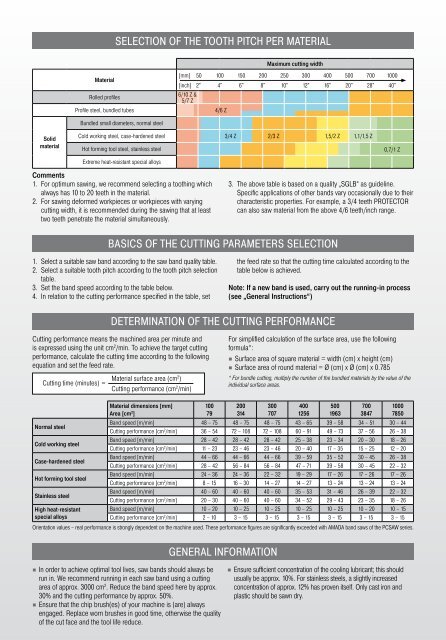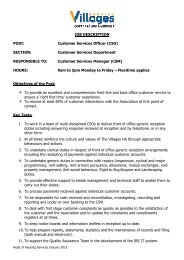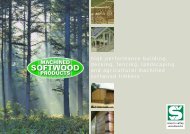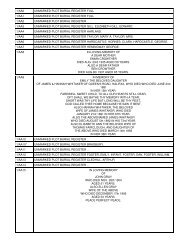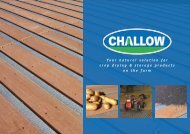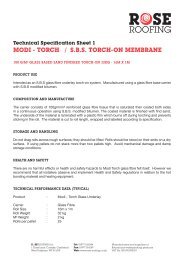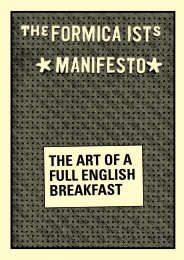Saw Bands
Saw Bands
Saw Bands
- No tags were found...
Create successful ePaper yourself
Turn your PDF publications into a flip-book with our unique Google optimized e-Paper software.
SELECTION OF THE TOOTH PITCH PER MATERIALMaximum cutting widthMaterialRolled profilesProfile steel, bundled tubes[mm]50 100 150 200 250 300 400 500 700 1000[inch] 2" 4" 6" 8" 10" 12" 16" 20" 28" 40"6/10 Z &5/7 Z4/6 ZBundled small diameters, normal steelSolidmaterialCold working steel, case-hardened steelHot forming tool steel, stainless steel3/4 Z 2/3 Z 1,5/2 Z 1,1/1,5 Z0,7/1 ZExtreme heat-resistant special alloysComments1. For optimum sawing, we recommend selecting a toothing whichalways has 10 to 20 teeth in the material.2. For sawing deformed workpieces or workpieces with varyingcutting width, it is recommended during the sawing that at leasttwo teeth penetrate the material simultaneously.3. The above table is based on a quality „SGLB“ as guideline.Specific applications of other bands vary occasionally due to theircharacteristic properties. For example, a 3/4 teeth PROTECTORcan also saw material from the above 4/6 teeth/inch range.BASICS OF THE CUTTING PARAMETERS SELECTION1. Select a suitable saw band according to the saw band quality table.2. Select a suitable tooth pitch according to the tooth pitch selectiontable.3. Set the band speed according to the table below.4. In relation to the cutting performance specified in the table, setthe feed rate so that the cutting time calculated according to thetable below is achieved.Note: If a new band is used, carry out the running-in process(see „General Instructions“)DETERMINATION OF THE CUTTING PERFORMANCECutting performance means the machined area per minute andis expressed using the unit cm 2 /min. To achieve the target cuttingperformance, calculate the cutting time according to the followingequation and set the feed rate.Cutting time (minutes) =Material surface area (cm 2 )Cutting performance (cm 2 /min)For simplified calculation of the surface area, use the followingformula*:■■Surface area of square material = width (cm) x height (cm)■■Surface area of round material = Ø (cm) x Ø (cm) x 0.785* For bundle cutting, multiply the number of the bundled materials by the value of theindividual surface areas.Normal steelCold working steelCase-hardened steelHot forming tool steelStainless steelHigh heat-resistantspecial alloysMaterial dimensions [mm]Area [cm 2 ]10079200314Band speed [m/min] 48 – 75 48 – 75 48 – 75 43 – 65 39 – 58 34 – 51 30 – 44Cutting performance [cm 2 /min] 36 – 54 72 – 108 72 – 108 60 – 91 49 – 73 37 – 56 26 – 38Band speed [m/min] 28 – 42 28 – 42 28 – 42 25 – 38 23 – 34 20 – 30 18 – 26Cutting performance [cm 2 /min] 11 – 23 23 – 46 23 – 46 20 – 40 17 – 35 15 – 25 12 – 20Band speed [m/min] 44 – 66 44 – 66 44 – 66 39 – 59 35 – 52 30 – 45 26 – 38Cutting performance [cm 2 /min] 28 – 42 56 – 84 56 – 84 47 – 71 39 – 58 30 – 45 22 – 32Band speed [m/min] 24 – 36 24 – 36 22 – 32 19 – 29 17 – 26 17 – 26 17 – 26Cutting performance [cm 2 /min] 8 – 15 16 – 30 14 – 27 14 – 27 13 – 24 13 – 24 13 – 24Band speed [m/min] 40 – 60 40 – 60 40 – 60 35 – 53 31 – 46 26 – 39 22 – 32Cutting performance [cm 2 /min] 20 – 30 40 – 60 40 – 60 34 – 52 29 – 43 23 – 35 18 – 26Band speed [m/min] 10 – 20 10 – 25 10 – 25 10 – 25 10 – 25 10 – 20 10 – 15Cutting performance [cm 2 /min] 2 – 10 3 – 15 3 – 15 3 – 15 3 – 15 3 – 15 3 – 15Orientation values – real performance is strongly dependent on the machine used. These performance figures are significantly exceeded with AMADA band saws of the PCSAW series.30070740012565001963700384710007850GENERAL INFORMATION■■In order to achieve optimal tool lives, saw bands should always berun in. We recommend running in each saw band using a cuttingarea of approx. 3000 cm 2 . Reduce the band speed here by approx.30% and the cutting performance by approx. 50%.■■Ensure that the chip brush(es) of your machine is (are) alwaysengaged. Replace worn brushes in good time, otherwise the qualityof the cut face and the tool life reduce.■■Ensure sufficient concentration of the cooling lubricant; this shouldusually be approx. 10%. For stainless steels, a slightly increasedconcentration of approx. 12% has proven itself. Only cast iron andplastic should be sawn dry.


